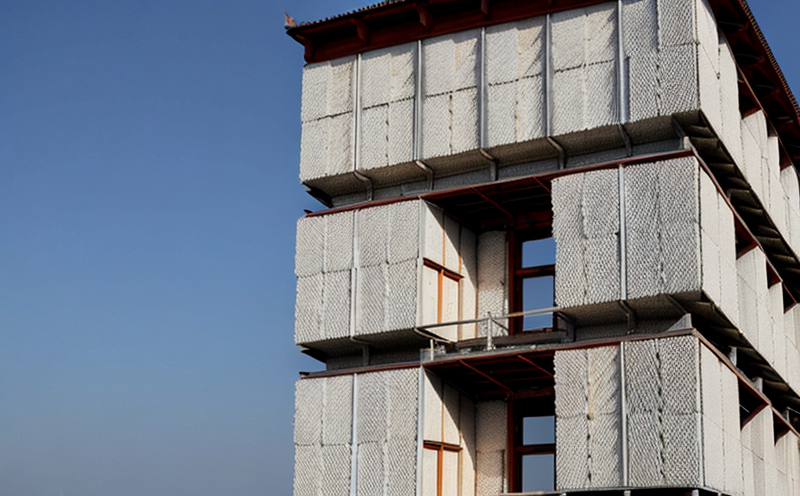Evaluating the effect of high-temperature exposure on the compressive strength of building materials
Evaluating the Effect of High-Temperature Exposure on Compressive Strength Ensuring Building Materials with Endurance
As buildings continue to rise towards the sky and urbanization accelerates, construction companies face immense pressure to deliver high-quality structures that can withstand various environmental conditions. Among these factors, temperature fluctuations play a crucial role in determining the lifespan and stability of building materials. High-temperature exposure is particularly relevant in regions prone to heatwaves, which can significantly impact the compressive strength of materials used in construction.
Eurolab offers an expert laboratory service to evaluate the effect of high-temperature exposure on the compressive strength of building materials. This comprehensive analysis ensures that construction companies and architects can make informed decisions when selecting materials for their projects.
Understanding High-Temperature Exposures Impact
High temperatures can lead to significant changes in the physical properties of building materials, affecting their durability and performance. The primary concern is the reduction in compressive strength, which can compromise a structures stability and integrity. The American Society for Testing and Materials (ASTM) defines high-temperature exposure as a condition where materials are subjected to temperatures above 100C (212F).
The Benefits of Evaluating High-Temperature Exposure on Compressive Strength
Using Eurolabs laboratory service provides numerous benefits, including
Predictive Maintenance By evaluating the effect of high-temperature exposure on compressive strength, construction companies can identify potential issues and take proactive measures to prevent material failure.
Enhanced Durability Understanding a materials thermal performance enables architects and engineers to select materials that are more resistant to temperature fluctuations, ensuring a longer lifespan for structures.
Reduced Costs Identifying potential weaknesses in materials saves construction companies from costly repairs or replacements down the line.
Improved Safety Knowing a structures thermal resilience ensures that buildings remain safe for occupants, even in extreme weather conditions.
Key Advantages of Using Eurolabs Service
Eurolabs laboratory service offers several advantages, including
Accurate Results Our expert technicians and state-of-the-art equipment ensure precise measurements and reliable results.
Comprehensive Analysis Our evaluation covers a range of parameters, providing a complete understanding of a materials thermal performance.
Customized Solutions Eurolab works closely with clients to develop tailored testing plans that meet their specific needs.
How Does the Testing Process Work?
Eurolabs laboratory service involves several stages
Material Selection Clients provide samples of the building materials to be tested.
Testing Procedure The samples are subjected to high-temperature exposure, simulating real-world conditions.
Data Analysis Our expert technicians analyze the results, providing a comprehensive report on the materials compressive strength and thermal performance.
QA Section
Here are some frequently asked questions about Evaluating the effect of high-temperature exposure on the compressive strength of building materials
Q Why is it essential to evaluate the effect of high-temperature exposure on compressive strength?
A High temperatures can significantly impact a materials physical properties, compromising its durability and performance.
Q What types of materials are typically tested for high-temperature exposure?
A Eurolab tests a wide range of building materials, including concrete, masonry, and steel.
Q How long does the testing process take?
A The duration of the test depends on the specific requirements of the project. Typically, results are available within 2-4 weeks.
Q Can I customize the testing plan to suit my needs?
A Yes, Eurolab works closely with clients to develop tailored testing plans that meet their specific requirements.
Conclusion
Evaluating the effect of high-temperature exposure on compressive strength is an essential service for construction companies and architects seeking to ensure building materials can withstand various environmental conditions. By using Eurolabs laboratory service, businesses can make informed decisions when selecting materials, reducing costs, and improving safety.
-
Testing the ability of materials to resist crushing forces or compression without failing
-
Evaluating the stress at which materials like concrete, steel, and composites begin to deform or fail
-
Simulating extreme weight and pressure scenarios to assess material resilience under compressive stress
-
Testing the maximum load that materials can support before reaching their compressive failure point
-
Ensuring that materials used in foundations and structural elements maintain their integrity under load
-
Verifying the compressive strength of concrete and other masonry materials used in construction
-
Ensuring that composite materials can handle compressive forces without significant damage
-
Testing the compressive properties of materials used in high-load environments, such as bridges and skyscrapers
-
Evaluating how materials perform under vertical load conditions, such as the weight of buildings and structures
-
Simulating pressure conditions to ensure materials will not collapse or buckle under heavy loads
-
Verifying that the strength of materials used in construction meets building code requirements for structural safety
-
Testing the ability of materials to maintain their shape and strength under constant pressure over time
-
Simulating the effect of thermal expansion and contraction on materials' compressive strength
-
Testing materials for their ability to withstand pressure during the freeze-thaw cycles in construction
-
Ensuring that materials like steel and aluminum maintain their integrity under compressive forces during manufacturing
-
Testing materials for their compressive strength in both dry and wet conditions to ensure performance consistency
-
Verifying that materials used for columns, beams, and load-bearing elements provide sufficient strength
-
Ensuring the longevity of materials under constant or cyclic compressive loads over time
-
Testing the resistance of materials to crushing forces when subjected to extreme weight distribution
-
Testing the compressive strength of materials used in flooring and wall systems to ensure safety
-
Ensuring that compressive stress does not cause cracking, warping, or other structural issues
-
Testing how well materials perform in confined spaces, such as tunnels or enclosed structures, under compression




